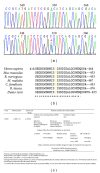Sporadic cerebral cavernous malformations: report of further mutations of CCM genes in 40 Italian patients
- PMID: 24058906
- PMCID: PMC3766605
- DOI: 10.1155/2013/459253
Sporadic cerebral cavernous malformations: report of further mutations of CCM genes in 40 Italian patients
Abstract
Cerebral cavernous malformations (CCMs) are vascular lesions characterized by abnormally enlarged capillary cavities, affecting the central nervous system. CCMs can occur sporadically or as a familial autosomal dominant condition with incomplete penetrance and variable clinical expression attributable to mutations in three different genes: CCM1 (K-Rev interaction trapped 1 (KRIT1)), CCM2 (MGC4607), and CCM3 (PDCD10). CCMs occur as a single or multiple malformations that can lead to seizures, focal neurological deficits, hemorrhagic stroke, and headache. However, patients are frequently asymptomatic. In our previous mutation screening, performed in a cohort of 95 Italian patients, both sporadic and familial, we have identified several mutations in CCM genes, three of which in three distinct sporadic patients. In this study, representing further molecular screening of the three CCM genes, in a south Italian cohort of CCM patients enrolled by us in the last three years, we report the identification of other four new mutations in 40 sporadic patients with either single or multiple CCM.
Figures



References
-
- Rigamonti D, Hadley MN, Drayer BP, et al. Cerebral cavernous malformation. Incidence and familial occurrence. The New England Journal of Medicine. 1989;319(6):343–347. - PubMed
-
- Labauge P, Denier C, Bergametti F, Tournier-Lasserve E. Genetics of cavernous angiomas. The Lancet Neurology. 2007;6(3):237–244. - PubMed
-
- Coban A, Gurses C, Bilgic B, et al. Sporadic multiple cerebral cavernomatosis: report of a case and review of literature. Neurologist. 2008;14(1):46–49. - PubMed
MeSH terms
Substances
LinkOut - more resources
Full Text Sources
Other Literature Sources

